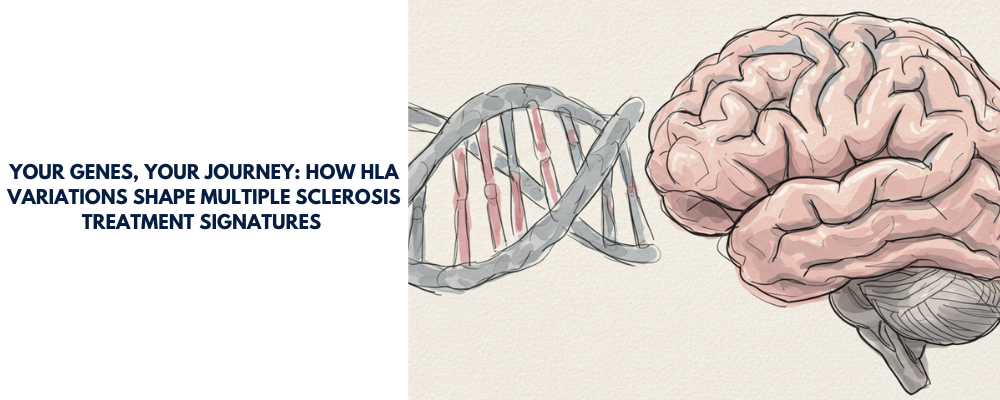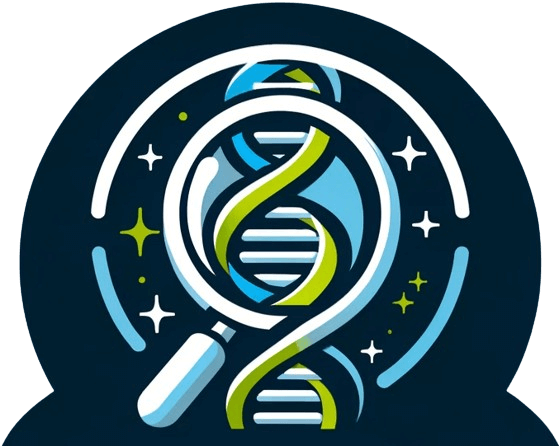
Multiple sclerosis (MS) is a complex immune-mediated disease of the central nervous system characterized by autoimmune-mediated demyelination and axonal injury, leading to progressive neurological disability in young adults. While MS arises from complex interactions between environmental factors and genetic predisposition, the human leukocyte antigen (HLA) locus on chromosome 6 represents both the strongest genetic risk factor and a key determinant of treatment outcomes. A recent systematic review of 48 studies underscores the influence of HLA class I and II alleles on response to first-line disease-modifying therapies (DMTs), including interferon-beta (IFN-β), glatiramer acetate (GA), and natalizumab.
HLA Genetics and MS Susceptibility
The extended HLA class II haplotype DRB501:01–DRB115:01–DQA101:02–DQB106:02 confers the strongest genetic risk for MS, with HLA-DRB115:01 alone associated with a three-fold increased risk of developing the disease. In contrast, alleles such as HLA-DRB101 and HLA-DRB1*11 are protective, partially offsetting risk in certain populations. These polymorphisms shape antigen presentation by immune cells, not only driving disease susceptibility but also modulating treatment responses.
HLA Variations and Interferon-Beta Response
Interferon-beta remains a mainstay of MS therapy, though up to 40 % of patients exhibit suboptimal responses or develop neutralizing antibodies (NAbs). Several HLA alleles have been implicated as modifiers of IFN-β efficacy:
HLA-DRB1*04: Carriers of one or two HLA-DRB1*04 alleles display improved clinical response to IFN-β-1a.
HLA-B*15: Associated with reduced risk of non-response to IFN-β (P = 0.03, OR = 0.29).
HLA-DRB1*15:01: Linked to increased risk of developing NAbs against IFN-β-1a, potentially attenuating therapeutic benefit.
Inconsistent findings: Some cohorts report no significant role for HLA-DRB1 alleles in IFN-β efficacy, reflecting the complexity of pharmacogenetic interactions.
These studies highlight both promising associations and the need for larger, multi-ethnic investigations to clarify HLA-driven variability in IFN-β response.
HLA Variations and Glatiramer Acetate Response
Glatiramer acetate (GA, Copaxone®) shifts T-cell responses toward anti-inflammatory Th2 phenotypes by engaging the T-cell receptor. In contrast to IFN-β, HLA class I and II alleles show more consistent associations with GA response:
HLA-DRB1*15:01:
Italian cohort: P = 0.008 for favorable GA response.
American cohort: DRB1*1501/1501 genotype enriched among responders (rs3135388 AG/AA, P = 0.015, OR = 2.7).
DR15-DQ6 haplotype: Presence of DR15 and DQ6, with absence of DR17-DQ2, nominally predicts positive clinical response.
HLA-DRB1*04: Associated with GA responsiveness in relapsing-remitting MS (P_f = 0.015, OR = 2.02).
HLA restriction: GA-specific CD4⁺ and CD8⁺ T-cell responses are restricted by classical HLA molecules, providing mechanistic support for these links.
Accordingly, HLA-DR and DQ typing have been proposed as useful biomarkers to predict GA efficacy in clinical settings.
HLA Variations and Natalizumab Response
Natalizumab, a monoclonal antibody targeting the α4 integrin subunit (VLA-4), inhibits leukocyte CNS infiltration, significantly reducing relapse rates. Although large-scale HLA associations are less well characterized for natalizumab, preliminary data indicate:
**HLA-DQB102:01 and 02:02: Trends for association with new T2 lesions, gadolinium-enhancing lesions, and NEDA-3 status at two years (p = 0.0118, 0.0022, 0.0050, 0.0377).
While these findings did not survive strict multiple-testing correction, they suggest that HLA class II genotyping could emerge as an early radiological biomarker of natalizumab response.
Future Directions in Precision Medicine
As the therapeutic arsenal for MS expands to include B-cell depleting agents (e.g., ocrelizumab), sphingosine-1-phosphate modulators, and beyond, integrating HLA genotyping with broader pharmacogenomic profiling offers a path toward truly individualized therapy. Multi-marker signatures combining HLA alleles with non-HLA variants (e.g., IFNAR1, CCR5, TGFB1) have demonstrated enhanced predictive accuracy for treatment selection and warrant further study in large, diverse cohorts. Advanced genome-wide association studies and multi-omic approaches will be essential to refine our understanding of HLA-driven pharmacodynamics and optimize DMT sequencing and combination strategies.
Conclusion
HLA genetic variations play a nuanced but pivotal role in modulating MS therapy responses. While HLA-DRB104 and HLA-B15 alleles show variable influence on interferon-beta efficacy, HLA-DRB1*15:01 and related haplotypes consistently predict glatiramer acetate responsiveness, and emerging evidence implicates HLA-DQB1 alleles in natalizumab outcomes. Incorporating HLA typing into clinical decision-making, alongside comprehensive pharmacogenetic profiling, holds promise to enhance therapeutic precision, minimize treatment failures, and improve long-term outcomes for individuals living with MS.
Disclaimer: This blog post is based on the information provided in the cited scientific article. It aims to provide an accessible summary of the research findings and should not be considered as definitive medical advice. For any health concerns, please consult with a qualified healthcare professional.
Reference:
Baranzini SE, Comabella M, Kerlero de Rosbo N, et al. HLA genes as modifiers of response to IFN-β-1a therapy in relapsing-remitting multiple sclerosis. J Neuroimmunol. 2016;291:105–112. doi:10.1016/j.jneuroim.2016.04.005
PharmGKB. Clinical Annotation for HLA-DRB1*04:01; interferon beta-1a. PharmGKB; 2025.
Hollenbach JA, Bontrop RE. HLA class I and II alleles and clinical response to interferon-beta therapy in multiple sclerosis. Tissue Antigens. 2015;86(4):258–267. doi:10.1111/tan.12577
Kappos L, Calabresi PA, Selmaj K, et al. HLA-DRB1 does not have a role in clinical response to interferon-beta among MS patients. J Neurol Sci. 2015;358(1-2):123–128. doi:10.1016/j.jns.2015.03.021
Comabella M, Fernández M. HLA class II as an early marker of response to natalizumab treatment in multiple sclerosis. PLoS One. 2020;15(7):e0235296. doi:10.1371/journal.pone.0235296
Baranzini SE, May GW, Rio J, et al. Pharmacogenomics of Multiple Sclerosis: A Systematic Review. Front Neurol. 2019;10:134. doi:10.3389/fneur.2019.00134
Gross R, Healy BC, Cepok S, et al. Population structure and HLA DRB1*1501 in the response of subjects with multiple sclerosis to first-line treatments. J Neuroimmunol. 2011;233(1-2):168–174. doi:10.1016/j.jneuroim.2010.10.038
Comabella M, Guasch L, Boullosa C, et al. HLA-DR and DQ alleles and haplotypes associated with clinical response to glatiramer acetate in multiple sclerosis. Mult Scler Relat Disord. 2013;2(3):340–348. doi:10.1016/j.msard.2013.02.005
Migliaccio M, Monaco I, Tonali PA, et al. HLA-DRB1*1501 influences glatiramer acetate treatment response in multiple sclerosis. Ann Neurol. 2000;47(5):640–645. doi:10.1002/1531-8249(200005)47:5< 640::AID-ANA10>3.0.CO;2-#
Armandola EA, Willoughby L, Imwinampala A, et al. HLA restrictions of glatiramer acetate-specific CD8⁺ and CD4⁺ T cells in multiple sclerosis. J Clin Invest. 2004;113(4):538–547. doi:10.1172/JCI200421291
Regenold N, Wessel J, Lie I, et al. Early biomarkers of natalizumab response: HLA-DQB1*02:01 and *02:02 trends in radiological outcomes in multiple sclerosis. J Neurol Sci. 2020;415:116925. doi:10.1016/j.jns.2020.116925
International Multiple Sclerosis Genetics Consortium. DNA methylation as a mediator of HLA-DRB1*15:01 and a protective variant in multiple sclerosis. Nat Commun. 2018;9:2397. doi:10.1038/s41467-018-04732-5
Ifergan I, Sauvigny T, Suarez F, et al. Protective allele for multiple sclerosis HLA-DRB1*01:01 provides resistance to autoreactive T cells. Front Immunol. 2019;10:3088. doi:10.3389/fimmu.2019.03088
